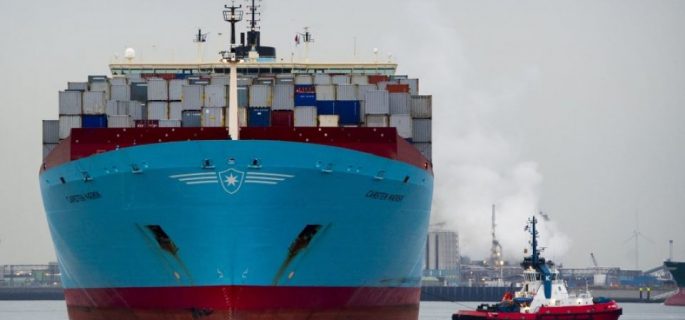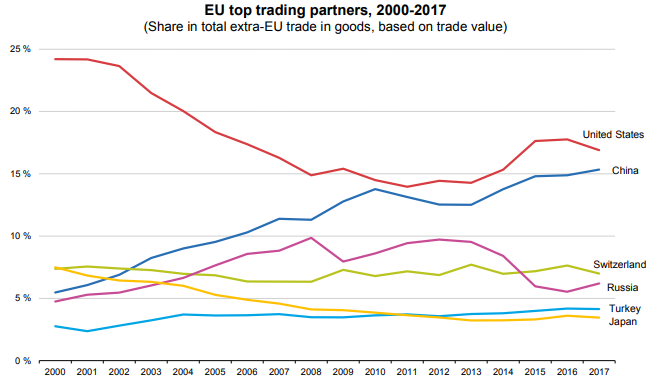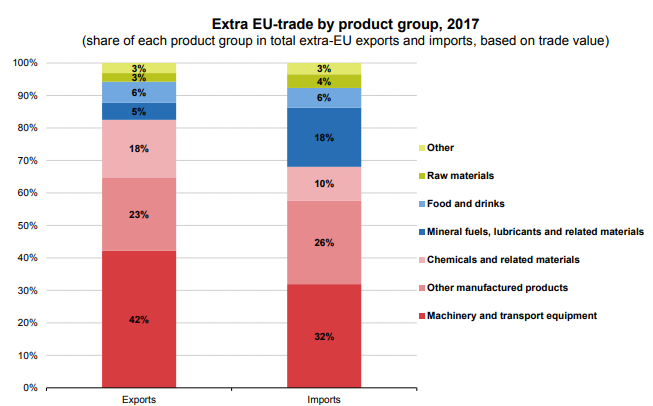These are the Countries that EU trades with the most

In 2017, the United States (€631 billion, or 16.9% of total EU trade in goods) and China (€573 bn, or 15.3%) continued to be the two main goods trading partners of the European Union (EU), well ahead of Switzerland(€261 bn, or 7.0%), Russia (€231 bn, or 6.2%), Turkey (€154 bn, or 4.1%) and Japan (€129 bn, or 3.5%).
However, the trends observed over time differ for these top trading partners of the EU. After recording a significant and almost continuous fall until 2011, the share of the United States in EU total trade in goods had increased to nearly 18% in 2015 and 2016, before decreasing again slightly in 2017. The share of China has almost tripled since 2000, rising from 5.5% to 15.3% in 2017. The share of Russia in total EU trade had been decreasing since 2012 from nearly 10% to around 6% in 2016, and slightly picked up in 2017. The share of trade with Japan has fallen by more than a half since 2000 – from 7.5% in 2000 to 3.5% in 2017. As for Switzerland and Turkey, their respective shares in trade remained relatively unchanged over the entire period.
In 2017, machinery and transport equipment, other manufactured goods and chemicals represented the main categories of product traded by the EU.
These data are issued by Eurostat, the statistical office of the European Union. A selection of infographics on international trade in goods is also available on the Eurostat website.

Germany, main export destination for a majority of Member States
In almost all EU Member States, the main partner for exports of goods in 2017 was another member of the European Union, except for Germany, Ireland, and the United Kingdom (the United States was the main destination of exports) as well as Cyprus (Libya) and Lithuania (Russia).
In some Member States, over a quarter of exports went to one single partner. This partner was Germany for the Czech Republic (33% of exports of goods), Austria (29%), Hungary (28%), Poland (27%) and Luxembourg(26%). 27% of exports of Ireland went to the United States and 25% of exports of Portugal went to Spain. Overall, Germany was the main destination of goods exports for 17 Member States and among the top three in 22 Member States.
For extra-EU trade, that is trade with non-EU countries, the 3 main destinations of EU exports in 2017 were the United States (20% of all extra-EU exports), China (11%) and Switzerland (8%).
Intra-EU exports prevail in all Member States apart from Cyprus and the United Kingdom
In 2017, the 28 EU Member States exported a total of €5 226 bn of goods, of which €3 347 bn (or 64%) were destined for another Member State of the EU (intra-EU trade).
With about three-quarters or more of goods exported to other EU Member States, Slovakia (86% intra-EU in total exports), Luxembourg and the Czech Republic (both 84%), Hungary (81%), Poland (80%), Romania and Slovenia (both 76%) and the Netherlands (75%) recorded in 2017 the highest shares of intra-EU exports. At the opposite end of the scale, Cyprus (37%) and the United Kingdom (48%) were the only Member States that exported more goods to non-EU countries than within the EU in 2017.
Germany, also main source of imports for more than half of EU Member States
As for exports, the main partner for imports of goods in 2017 was another member of the European Union in all Member States except Lithuania, for which Russia was the main country of origin of goods imported, and the Netherlands (China).
In seven Member States, more than 25% of imports of goods came from a single partner country in 2017: Austria (42% of imports of goods originated from Germany), Luxembourg (32% from Belgium), Portugal (32% from Spain), the Czech Republic (30% from Germany), Ireland (29% from the United Kingdom), Poland (28% from Germany) and Hungary (26% from Germany). Overall, Germany was among the top three countries of origin of goods imported in all EU Member States except Ireland and Cyprus.
For extra-EU trade, the main country of origin of goods imported into the EU in 2017 remained China (20% of all extra-EU imports), followed by the United States (14%) and Russia (8%).
Intra-EU imports prevail in almost all Member States
In 2017, the 28 EU Member States imported a total of €5 131 bn of goods, of which €3 276 bn (or 64%) came from another EU Member State (intra-EU trade).
Over three-quarters of total imports of goods originated from another EU Member State in Luxembourg (83%), Estonia (81%), Slovakia (80%), Latvia (79%), the Czech Republic and Croatia (both 78%), Austria (77%), Portugal, Hungary and Romania (all 76%). In contrast, the Netherlands (46%) was the only Member State where less than half of the imports came from within the EU. This is largely due to the so-called ‘Rotterdam effect’ (see country note).
Machinery & transport equipment dominated both EU exports and imports
In 2017, machinery and transport equipment continued to play a major role in EU trade in goods with the rest of the world, accounting for 42% of total extra-EU exports and 32% of imports. Other manufactured goods (23% of extraEU exports and 26% of extra-EU imports) as well as chemicals (18% of extra-EU exports and 10% of extra-EU imports) also played a significant role in EU trade in goods in 2017. Mineral fuels made up a minor share of extra-EU exports (5%), but accounted for 18% of all imports.

Source: eurostat – A third of EU trade is with the United States and China




























